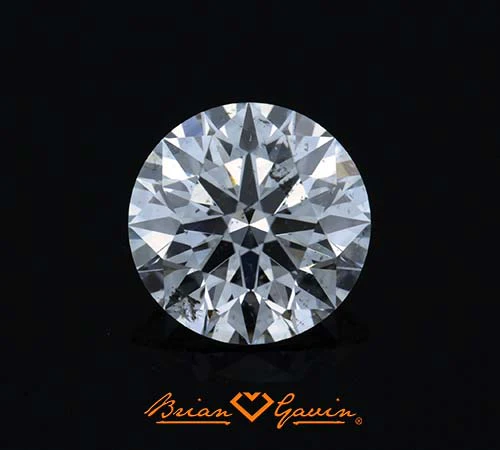
Are BGD Signature diamonds eye clean from the bottom of the diamond?
“I’m interested in this 1.062 carat, G-color, SI-2 clarity, Brian Gavin Signature round diamond, which is described as eye clean; but I see a lot of inclusions in the clarity photograph and video provided for the diamond, and my understanding is that it is more difficult to see flaws within a diamond when looking at it from the top, than it is to see the flaws from a side profile. I’m concerned because my girlfriend has really good vision, and I’m afraid that she’ll be able to see the inclusions with just her eyes. I really want to buy her a one carat diamond, and this diamond is at the top of my budget, what do you suggest?”
How to determine whether a diamond is eye clean online:
The advantage to working with dealers like Brian Gavin, who house their own inventory, as opposed to selling from a virtual inventory of diamonds, is that we are able to provide you with an accurate assessment of the diamond, and determine to what degree the diamond is, or is not, eye clean.
When a diamond grader looks at a diamond to determine the extent to which it is eye clean, they look at the diamond from a distance of nine to twelve inches, to see whether they are able to see the inclusions within the diamond readily and immediately without magnification; if they are able to see the inclusions within the diamond with just their eyes, the diamond is not eye clean.
The key phrase here is “readily and immediately” because a trained diamond grader is almost always going to be able to find the inclusions within an SI-2 and possibly even an SI-1 clarity diamond with just their eyes, upon close examination or careful scrutiny of the diamond facet-by-facet, because years of diamond grading experience makes it easier for them to locate and identify the inclusions.
Why it is easier to see inclusions through the side of a diamond:
The facets of a diamond are designed to act like tiny mirrors and reflect light which enters the diamond, and which strikes off the surface of a diamond, back up towards the observer; the light reflecting off of the facets makes it more difficult for our eyes to focus upon the inclusions contained within the natural diamond crystal.
 If you look at the plotting diagram of the 1.06 carat, G-color, SI-2 clarity, BGD Signature round diamond provided to the left, you’ll see that the majority of facets are located on the upper half of the diamond; there are 8 triangular shaped Star facets; 8 kite shaped Bezel facets; 16 triangular Upper Girdle facets, and a flat table facet, for a combined total of 33 facets. The bottom portion of the diamond, which is known as the pavilion, consists of an 8 pointed star, which is created by the Pavilion mains; and 16 lower girdle facets, which separate the pavilion main facets, and a bottom point known as the culet, for a total of 24 facets, or 25 facets if you count the culet as a facet.
If you look at the plotting diagram of the 1.06 carat, G-color, SI-2 clarity, BGD Signature round diamond provided to the left, you’ll see that the majority of facets are located on the upper half of the diamond; there are 8 triangular shaped Star facets; 8 kite shaped Bezel facets; 16 triangular Upper Girdle facets, and a flat table facet, for a combined total of 33 facets. The bottom portion of the diamond, which is known as the pavilion, consists of an 8 pointed star, which is created by the Pavilion mains; and 16 lower girdle facets, which separate the pavilion main facets, and a bottom point known as the culet, for a total of 24 facets, or 25 facets if you count the culet as a facet.
The higher number of facets located on the upper half, or crown section of the diamond, makes it more difficult to locate and identify inclusions, because they act like tiny mirrors and reflect the light which is entering the diamond from the top.
However the inclusions located in the pavilion section, or lower half of the diamond, are easier to locate from a side profile, because light is not reflecting off of the facets from that perspective, it is being directed back out through the top of the diamond by those facets; and thus the facets are essentially tiny mirrors which enable you to look into the diamond, making it much easier to locate inclusions in a diamond from a side profile.
Thus it might be possible for a trained diamond grader to be able to locate the inclusions in diamonds of higher clarity, such as the VS and VVS clarity grades, from a side profile. The good news is that people generally don’t spend a lot of time scrutinizing their diamonds from a side profile, because they look much more interesting from the top, where all the light which enters them is being converted into the sparkle that mesmerizes our senses!
Whether the Brian Gavin Signature diamond you select is an eye clean SI-2 or a VVS-1 clarity diamond, you can rest assured that the sparkle factor of the diamond is going to be the primary focus… I’d buy the 1.062 carat, G-color, SI-2 clarity, Brian Gavin Signature round diamond because it enables you to present your girlfriend with the one carat diamond that you want to give her, and not worry so much about whether the diamond is absolutely 100% eye clean under all circumstances, the odds are that she’s less concerned about that than you are ;-)




















